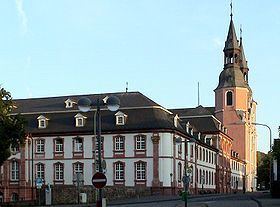Second foundation 752 1222 Founded 1222 | Government Principality First foundation 721 Preceded by Succeeded by | |
 | ||
Similar Basilica of the Transfigu, Hersfeld Abbey, Abbey of Echternach, Lissingen Castle, Fulda monastery | ||
Prüm Abbey is a former Benedictine abbey in Prüm, Lorraine, now in the diocese of Trier (Germany), founded by the Frankish widow Bertrada and her son Charibert, Count of Laon, on 23 June 720. The first abbot was Angloardus.
Contents
Abbey's early period up to the 13th century
Bertrada of Prüm's granddaughter was Bertrada of Laon, wife of King Pepin the Short (751–68). Prüm became the favourite monastery of the Carolingian dynasty and received large endowments and privileges. Pepin rebuilt the monastery and bestowed great estates upon it by a deed of gift dated 13 August 762. The king brought monks from Meaux under Abbot Assuerus to the monastery.
The church, dedicated to the Saviour (Salvator), was not completed until the reign of Charlemagne, and was consecrated on 26 July 799 by Pope Leo III. Charlemagne and succeeding emperors were liberal patrons of the abbey. Several of the Carolingians entered the religious life at Prüm; among these was Charlemagne's illegitimate son Pepin the Hunchback, who was exiled there after an abortive uprising and died there in 811, and Lothair I, who became a monk in 855. His grave was rediscovered in 1860; in 1874, the Emperor Wilhelm I erected a monument over it.
In 882 and 892, the monastery was plundered and devastated by the Normans, but it soon recovered. The landed possessions were so large that the abbey developed into a principality.
At times during the eleventh and twelfth centuries, the monastery contained over three hundred monks. The period of its internal prosperity extends to the thirteenth century. The monks were energetic cultivators of the land. About 836, Abbot Marquard founded a new monastery at Münstereifel. In 1017, Abbot Urald founded at Prüm a collegiate foundation for twelve priests. In 1190, Abbot Gerhard founded a house for ladies of noble birth at Niederprüm. The monastery cared for the poor and sick. Learning was also cultivated. Among those who taught in the school of the monastery were Ado, later archbishop of Vienne (860–75). Another head of the school, Wandelbert (813–70), was a distinguished poet. Abbot Regino of Prüm (893–99) made a name for himself as historian and codifier of canon law. Caesarius of Heisterbach is only brought into the list of authors of this monastery by being confounded with Abbot Caesarius of Prüm (1212–16).
After the 13th century
In the 13th and 14th centuries, the monastery declined, partly from the oppression of its secular administrators, but more from internal decay. It reached such a pass that the monks divided the revenues among themselves and lived apart from one another.
Consequently, the archbishops of Trier sought to incorporate the rich abbey and its extensive possessions into the archbishopric. In 1376, Emperor Charles IV gave his consent to this, as did Pope Boniface IX in 1379, but the pope's consent was recalled in 1398. Pope Sixtus IV in about 1473 also gave his approval to the incorporation. But the abbots refused to submit and even in 1511 carried on war against the archbishop, by then an elector. Finally, when the abbey was near ruin, Pope Gregory XIII issued the decree of incorporation, dated 24 August 1574, which was carried into effect in 1576 after the death of Abbot Christopher of Manderscheid.
After this, the archbishops-electors of Trier were "perpetual administrators" of the abbey. The abbey was now brought into order within and without, and once more flourished to such a degree that the two French Benedictine antiquarians Edmond Martène and Ursin Durand, who visited the monastery in 1718, stated in their Voyage littéraire that of all the monasteries in Germany, Prüm showed the best spirit, and study was zealously pursued. The monks made efforts even in the 18th century to shake off the supremacy of Trier.
In 1801, Prüm fell to France, was secularized, and its estates sold; Napoleon gave its buildings to the city. In 1815, Prüm passed into the possession of Prussia as a part of the Rhine Province, and in the course of time became part of modern Germany, in the State of Rhineland-Palatinate.
The church, built in 1721 by the Elector Ludwig, is now a parish church. The remaining monastic buildings are now used for the secondary school named the Regino-Gymnasium after the Abbot Regino of Prüm.
Abbey relics
The Sandals of Jesus Christ are considered to be the most notable of the many relics of the church; they are mentioned by Pepin in the deed of 762. He is said to have received them from Rome as a gift of Pope Zachary or Pope Stephen II.
